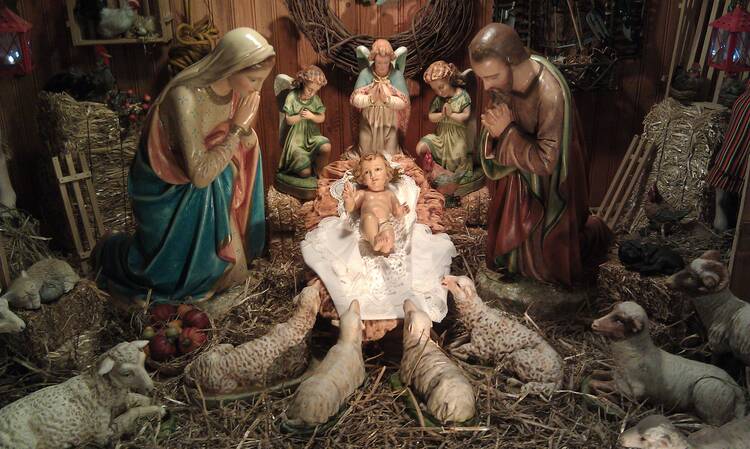Every year at Christmas, upon my return home, I always make an extra effort to visit my alma mater. My primary reason is clear: to visit friends that I made amongst the faculty and staff when I was a student there and with whom I still try to keep close ties. But I do retain a secondary reason for my visit every year, and that is to make an advent/Christmas pilgrimage. I visit the high schools’ crèche. It may seem odd for me to go out of the way to see a nativity scene in a chapel miles from my family’s home, but I do so because its’ a crèche that is rather foreign to the ones most of us are familiar with today. Rather than the standard Fontanini statues and the one or two sheep present in some hay, closely watched by their shepherds, this crèche plays into a much older and awesome tradition.
The definition of pilgrimage, according to Merriam-Webster, is: 1. A journey of a pilgrim, especially to a holy place. We are meant as individuals to experience Christ, in all stages of his life, as if it were occurring in front of us today. That is why throughout Lent, and especially on Good Friday, a special effort is made to bring us closer to the suffering and death of Jesus on the Cross, so we can more fully take part in the joy of the ensuing Resurrection. It should be the same with the Nativity, and for centuries it was.
The crèche in the Chapel at my high school brings the Nativity alive. It is constantly busy with water features and glowing lights for fires, showing the raw need for basic sustenance. The animals and foliage are all based on species present in my own area so as to make it more familiar, more relatable. And, as a personal touch, the Jesuit who maintains the crèche personally salvaged and restored, along with his father, all of the statuary in the scene so that each and every detail is personalized and more familiar. Every feature is meant to ensure that those who witness the Nativity are there to really witness it, and not just observe. We are meant to relate to the Nativity, finding a great joy and consolation at so humble an entrance of God into the world. We are meant to enter into a holy place.
For hundreds of years, after St. Francis first created the Nativity scene in a cave near Greccio, Italy during the 13th-century, Christians around the world have sought ways to familiarize themselves with the Nativity. Matthew Powell, O.P., relates that in Salzburg, for the Christmas of 1616, crèches with changing scenes were first exhibited in the churches of Franciscans, Augustinians and Capuchins, displaying scenes from the Annunciation through the Flight into Egypt. Powell also writes extensively on Jesuit influence regarding the crèche, writing “In the seventeenth century no one understood the value of the crèche devotion better than the Jesuits” (The Christmas Creche, Matthew Powell, O.P., 1997).
The devotion to the crèche fits perfectly into Jesuit spirituality, which is rooted heavily in imaginative prayer and thought. St. Ignatius of Loyola actually wrote a meditation on the Nativity well suited for an individual present before a crèche. In Spiritual Exercises #114, Ignatius calls us to visualize Our Lady “about nine months with child,” travelling to Bethlehem; to consider how “Our Lady and Joseph have traveled and Labored” and imagining oneself as an “unworthy servant, gazing upon them and serving them…with all respect and reverence.” Ignatius places us right in front of the Christ Child, and asks us to recognize the fact that, before this infant, man in his weakest form, born in a manger, we are to be awe struck and filled with joy at God’s love for us in the Incarnation.
There is much to be taken from the Nativity. As a father, one may contemplate on the struggles St. Joseph faced: the humiliation of having a son out of wedlock in Ancient Judea and the acceptance of the will of God in his life. As a mother, one may recognize the love and compassion that only a mother can display towards her child. Even as a bystander, one can recognize the love of a family, the call to witness the Incarnation of God amongst men, to see love present before us, or even just open oneself to the contemplation of what Christ’s entering the world really means for us as individuals.
In the United States, it is more and more apparent that the Christmas crèche is just becoming another mass-produced fixture in our church communities that we need to take a hold of once more and make our own. Throughout the world, the Nativity is still celebrated with live scenes and real animals, with processions and nativity building competitions, and so many other things that make it a central part of the Christmas celebration. We need to recognize that we are entering a holy place, but we also need to make the birth of Christ real and relatable once again. We need to know Him on a personal and deeper level. As in all things, a lack of familiarity rarely breeds depth. So, make a Christmas pilgrimage! Go and find Christ present as an infant and ask what that birth, the birth that changed the history of mankind, really means to us today.








